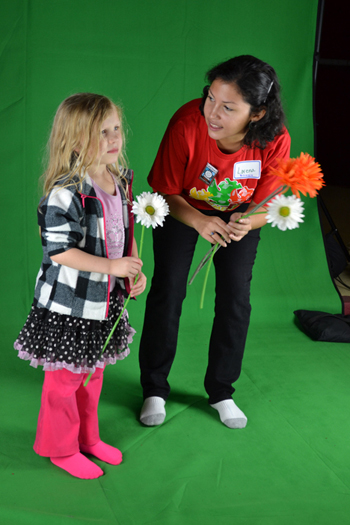
A local youngster and Illinois grad student Lorna Rios stand in front of a green screen to "dance with plants."
IGB's Genome Day Exposes Visitors to Genomic Research
November 13, 2013
From watching themselves dance with plants on a video screen, to using a ProScope to examine coral and fossils, to measuring the temperature of a "Yellowstone National Park hot spring," around 500 area youngsters (and their parents) who attended Genome Day on Saturday, November 2, 2013, got to learn a whole lot about genomics.
Sponsored by the Institute for Genomic Biology (IGB), the second annual Genome Day held at the Orpheum Children's Science Museum exposed visitors to exhibits that helped them understand all about genomes—an organism's hereditary information (genes) encoded in DNA. Among this year's 100+ volunteers were IGB undergrads, grads, post-docs and fellows, faculty, and staff, as well as volunteers from the Biomedical Engineering Society, Center for the Physics of Living Cells, and Neuroscience Club. Unique for this year, the event was presented in Spanish as well as English; each exhibit had an interpreter, courtesty of members of the Illinois chapter of SACNAS (Society Devoted to Advancing Hispanics, Chicanos, & Native Americans in Science).
Genome Day's 14 exhbits gave youngsters the opportunity to learn about a number of areas of genomic research, including genes, human or plant genomes, DNA, and evolution, plus skills/instruments scientists use in research.
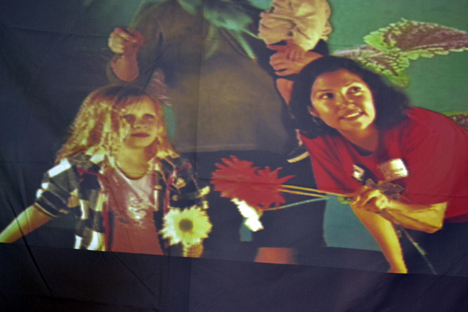
This is an image of the video the young visitor and grad student Lorena Rios saw of themselves dancing with plants.
For example, at the "Dancing With Plants" exhibit, youngsters who frolicked in front of a green screen could simultaneously, through the magic of videography, see themselves in a time-lapse video of germinating seeds and plants responding to gravity (gravitropism) and light (phototropism). Thus, in addition to the fun of seeing themselves "on tv," they learned about plant biology too.
Lorena Rios, a second year Ph.D. student in Plant Biology, "absolutely enjoyed the experience of introducing plant biology concepts into young minds" at Genome Day last year, so this year she agreed to be in charge of "Dancing with Plants." Rios hopes she piqued a few kids' interest in science: "I hope this exposure to plant biology will spark questions and create memories that could influence the future educational pathways of our children."
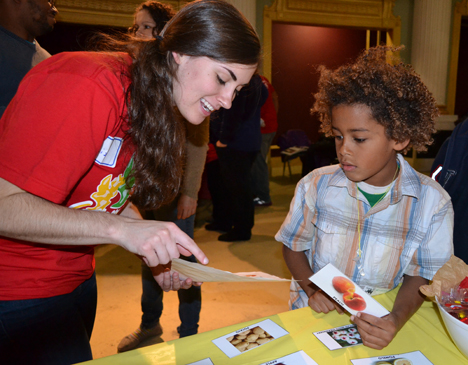
Physical Chemistry Ph.D student Liz Ryland explains genetic modification to Robert King
Physical chemistry Ph.D. student Liz Ryland introduced youngsters to genetic modification; using crossbred fruits, she taught the kids about genomic hybrids. After showing youngsters images of common fruit hybrids (grapefruit, tangelo, grapple, etc.), she had the kids try to figure out each hybrid's genetic 'parent' fruits, based on physical attributes. Adds Ryland, "We also mentioned Punnett squares," (diagrams scientists use to predict an outcome of a particular cross or breeding experiment). "But they tended to go over most of the kid's heads," she admits.
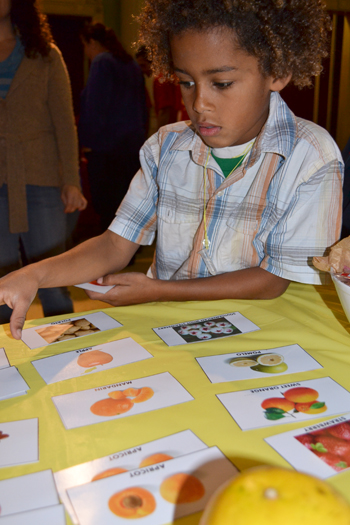
Robert King junior works to match fruit hybrids with their parents at Ryland's Genome Day exhibit.
Ryland, whose research is inorganic spectroscopy using an ultrafast XUV (extreme ultra-violet) instrument, says she participated in Genome Day to help kids learn to enjoy science:
"I just heard about it and thought it would be fun. Science is cool, and it's good for kids to be exposed to it at an early age, when they still think of science as something fun and neat to understand, rather than something attached to a letter grade."
Ryland believes the event had a positive impact on kids. "Most of the children (and parents) who came to our booth were able to learn something and have a good time, which I think is what the day was about."
One local youngster Ryland explained genomic hybrids to was Robert King. His father, Robert King, senior, admits that he brought Robert junior and his younger brother to Genome Day for more than a fun family outing: his son is interested in science, and he hopes to foster interest in a STEM (science, technology, engineering, mathematics) career.
"Robert is very curious," says King senior, "and he believes at a young age that he will someday be a scientist. He says this very often…so this was a nice family event to bring the crew."
Did Robert junior enjoy the event? "Yes…He always enjoys anything science related. He enjoyed the plant history science section and the DNA-making section the most."
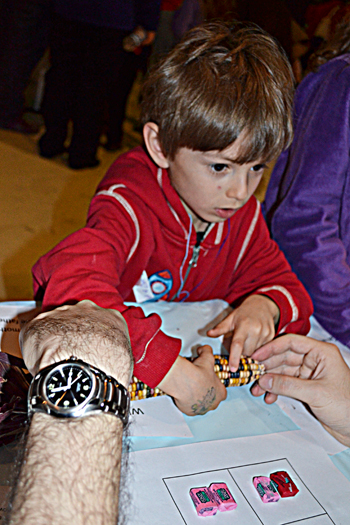
Local youngster examines some calico corn while learning about dominance and co-dominance in genes.
Juan Villeta-Garcia, a fourth-year Ph.D student in mathematics and SACNAS member, says he participated in Genome Day to give back to the community: "I thought it would be a great opportunity to volunteer and help out the Champaign youth."
His exhibit, "Egg Genetics," focused on understanding the difference between dominance and co-dominance in genes. In addition to hands-on examples of both phenomena, the kids also got to experiment with some candy-filled eggs.
Villeta-Garcia believes it was a positive experience for the youngsters: "I think it really motivated them. They saw that science is all around us, and not just in a textbook in class. Furthermore, it can be quite fun!"
Since Genome Day emphasizes hands-on learning, the kids who showed up got their hands on some fun instruments genomic researchers use. At one exhibit, youngsters used a ProScope (a wireless, handheld digital microscope), which magnified the samples 50X and projected the images to a computer screen kids could look at. At this exhibit, kids looked at rock and animal (claw and horn) samples from Yellowstone National Park and coral samples from Florida and Curaçao.

Jim Bruce supervises while a local youngster uses the ProScope to magnify rocks and coral.
Jim Bruce, a Molecular and Cellular Biology undergrad who manned the ProScope, says he got involved with Genome Day because he loves working with kids:
"I really enjoy being involved in any sort of education, especially science outreach, whenever I can. I have worked with kids since high school, but science experiments are definitely the most exciting experiences for most kids that I work with. Maybe this is just because they can see that it is my favorite too!"
Bruce, who is headed to medical school next fall, believes outreach events can foster curiosity in kids, plus show them that being a scientist can be fun.
"Events like Genome Day are very important for children to explore whatever curiosity they feel and ask the questions that they always have about the world! Too often, scientists are portrayed as being on a workbench in a lab coat their entire life, and our group likes to dispel that myth by showing how a good scientist can combine benchwork with field experiences such as SCUBA diving in a coral reef! The whole point is to help kids find things that they are really excited about, and help them learn to ask the right questions."
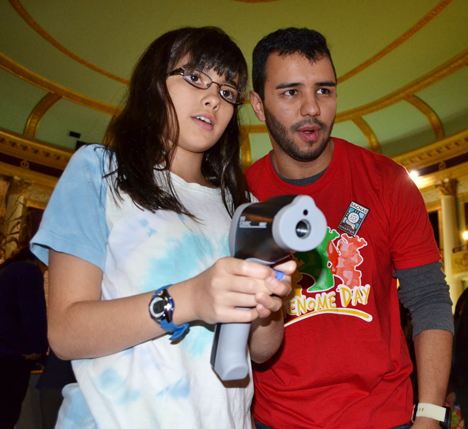
Local youngster and Illinois grad student and SACNAS member use an infrared thermometer to measure the temperature of a hot spring simulation.
At another station, kids got to use a kind of "temperature gun" to measure the temperature of a Yellowstone National Park "hot spring." An image of Yellowstone's Grand Prismatic Spring served as the hot spring, complete with a hot water bath at its base for students to measure its temperature and a fog machine to simulate steam. Using an infrared thermometer that enbled them to measure temperature from a distance (it's also called a laser thermometer because a laser helps it aim), kids measured the amount of infrared energy the hot spring emitted to determine its temperature.
So how hot was it? According to IGB grad student Susan Kelly, who has done a lot of work at Yellowstone, "We had it set at around 125 F, which is coincidentally almost the limit of life for photosynthetic organisms in the hot springs."
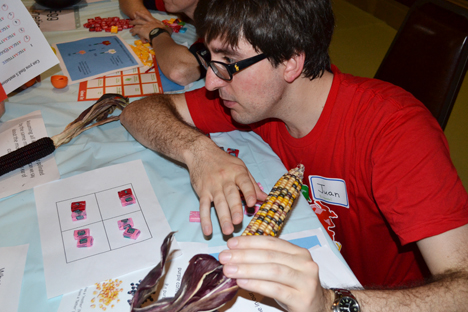
Juan Villeta-Garcia uses calico corn to demonstrate dominance and co-dominance in genes.
What impact did Genome Day have? According to IGB's Director of Development & Outreach, Melissa McKillip, parents were impressed by the exhibitors' ability to explain their research to children of different age groups. "One of the most frequently heard comments, reports McKillip, "was that the volunteers were able to adjust their activities to be age appropriate for the children they encountered." Another frequently heard comment? According to McKillip, it wasn't just the kids who learned some stuff. A number of adults were overheard saying, "I learned something today!"
Grad student Susan Kelly hopes some of the kids end up in science. "Well, hopefully, it got kids excited about science, which is what we try to do, right?" replies Kelly. "Get them excited about science, getting them to learn that there are different topics inside of science that they can study, and that they can be a scientist too."
She also hopes it had an impact on Illinois students who participated. "And I think the other implicit goal is to train the next generation of scientists, i.e., the graduate students, about the realities of education, and how to communicate education to the public in an effective way. That's what I'm interested in doing."
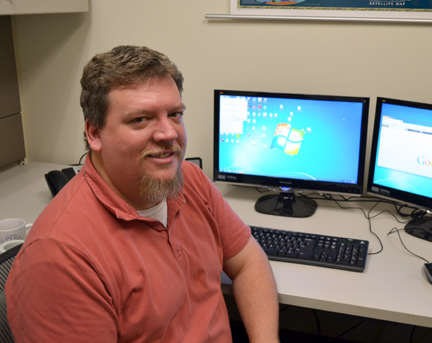
Scott Woolbright, co-chair of the 2013 Genome Day.
Scott Woolbright, co-chair of the event, believes their outreach got some kids interested in science. "Speaking with friends of mine whose kids attended, I think it's just a good way to get them excited about science. It's really interesting. We use colorful or fun exhibits. It's more than just teaching…it's very interactive, so hopefully that captures someone's imagination."
Woolbright agrees that Genome Day isn't just for kids. "I think we hear more sometimes out of the parents, saying, 'Oh, we really learned something.' So it's not just the kids; we actually do reach the parents as well."
Story and photographs by Elizabeth Innes, Communications Specialist, I-STEM Education Initiative.
More: Biology, K-12 Outreach, Orpheum, SACNAS, 2013

Genome Day had something for everyone. Here a 23-month-old youngster, in possibly his first exposure to genomic research, finds one of the displays intruiguing.













.jpg)
















